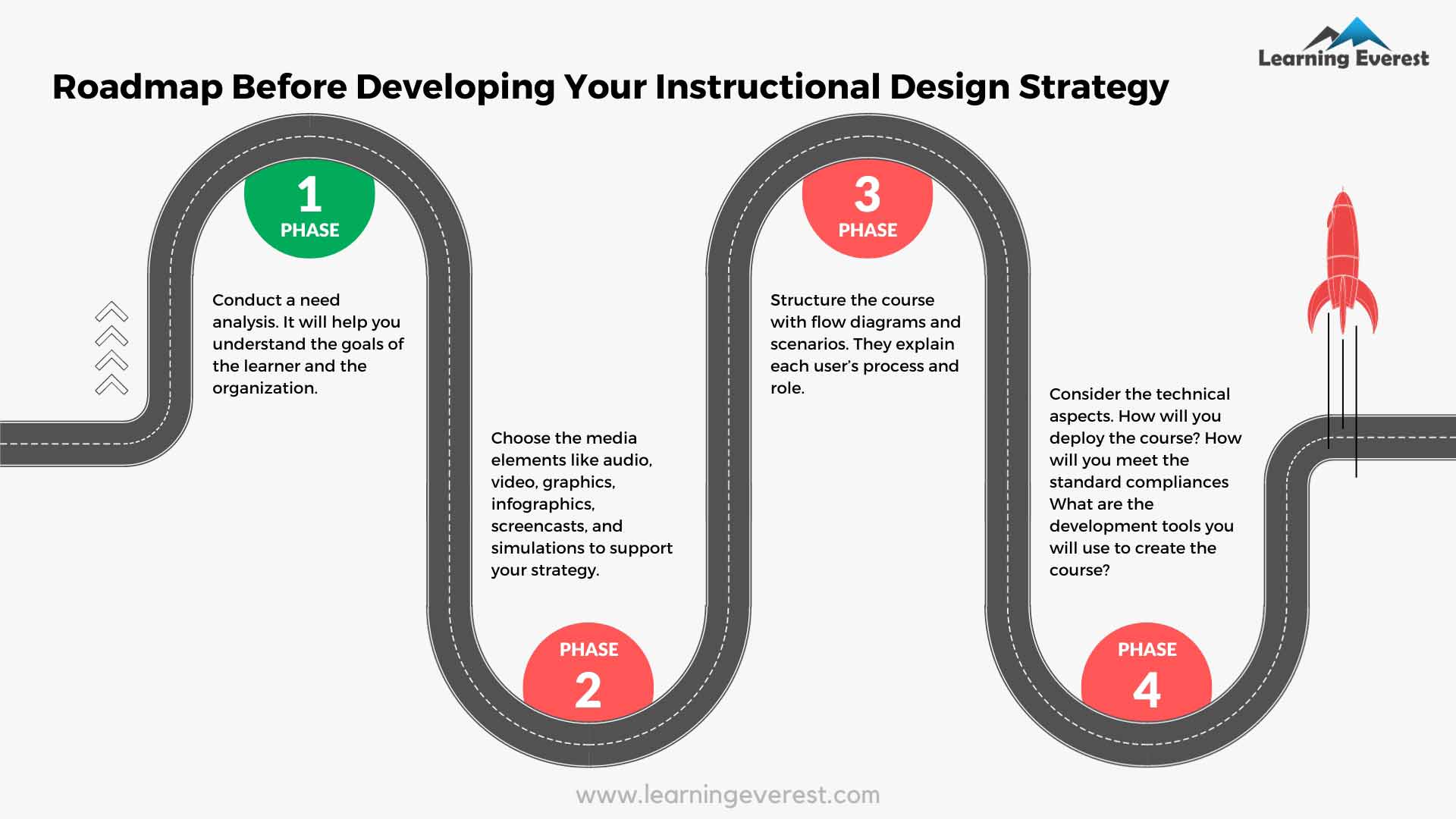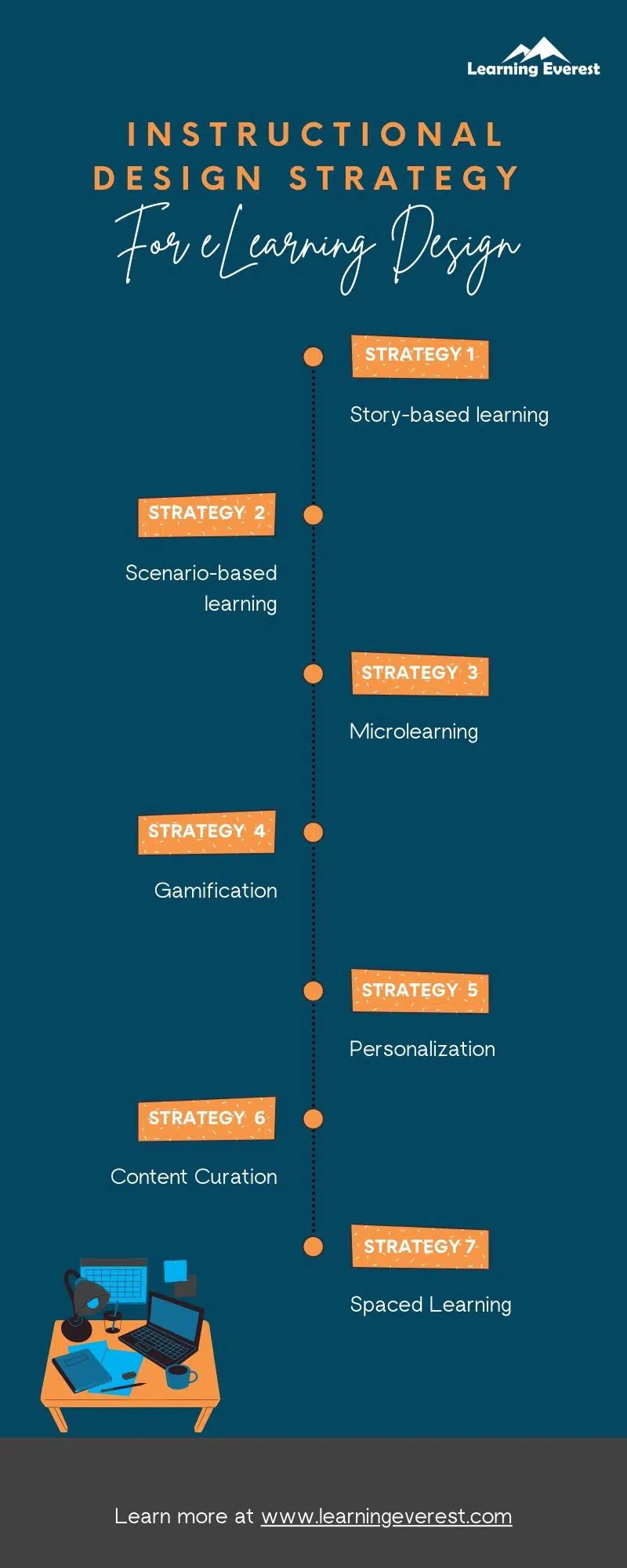A strategy is a plan of action. Your organization must have a strategy to achieve a long-term aim. Why do we have to discuss strategy in connection with corporate training? Why are the techniques used in creating and developing an eLearning course important? Let us find out the learning strategies and design in eLearning! What are the instructional design strategies in eLearning design?
Table of Contents
- What is a Strategy? Why Do We Need Strategies in Corporate Training?
- What is an Instructional Design Strategy?
- Instructional Design Strategies
- Importance of Instructional Design Strategy In eLearning Course
- Infographics
- Knowledge Check!
- Frequently Asked Questions (FAQs)
- What are the instructional strategies?
- What is instructional design?
- What are instructional design models?
- What does an instructional designer do in an eLearning process?
What is a Strategy? Why Do We Need Strategies in Corporate Training?
The strategy involves planning. Every task needs a plan for successful execution. We need strategies in corporate training. The main aim of the training is to facilitate knowledge transfer. With corporate training now moving online, we need strategies to ensure knowledge transfer is effective via the online medium. The online medium is where instructional design strategies become essential.
What is an Instructional Design Strategy?
An instructional design strategy is to how a particular subject will be taught. It is a detailed plan for the designing of an eLearning course. It consists of the methods, techniques, and devices used to instruct learners. ID strategies are selected based on the topic, learner characteristics, and more. They include using avatars, scenarios, simulations, and more.
It begins with identifying and listing the course objectives. The Instructional Design Strategy also identifies the course objectives’ actions using various resources and learning theories. So, how do you find out your ID strategy?
There are some essentials you must do before developing your Instructional Design Strategy. They are:
- Firstly, conduct a need analysis. It will help you understand the goals of the learner and the organization.
- Conduct questionnaires or conduct face-to-face or group meets.
- Observe the learners and gain crucial insights.
- Thus, you can find the learner-centered instructional strategy with which the learners would be most comfortable.
- Secondly, choose the media elements to support your strategy.
- Media elements include audio, video, graphics, infographics, screencasts, and simulations.
- eLearning courses are now designed for all types of devices.
- However, consider the learning devices on which the course will be accessed while choosing the media elements.
- Thirdly, structure the course with flow diagrams and scenarios.
- They explain each user’s process and role.
- Define the layout of the course.
- Finally, consider the technical aspects.
- How will you deploy the course?
- How will you meet the standard compliances?
- What are the development tools you will use to create the course?

Roadmap Before Developing Your Instructional Design Strategy
Instructional Design Strategies
You are all set to develop an ID strategy to create an eLearning course. Let’s find out what are the different instructional design strategies!
1. Story-based learning
eLearning courses in the form of a story can keep the learner engaged. Stories can make a personal connection. Create an emotional learning experience with a story.
The following elements in a story can keep the learners engaged:
- A thought-provoking storyline
- A strong narrative
- Characters who are relatable
- Elements of suspense
- Creating anticipation
How do you do it?
- You can create a situation in which the learner is the central character of the plot.
- Your learner must have the control to take the story forward.
- The learner must attain the learning goals through the process.
- You can create a conflict situation.
- Ensure the story has elements of suspense and anticipation.
- The learners must be allowed to bring a logical conclusion to the story.
2. Scenario-based learning
Scenario-based learning helps to improve learner engagement.
- It challenges them to explore a task at hand, prompting them to make the right decisions. Thus, the learners meet the learning objectives.
- It is ideal for bringing behavioral changes.
- Learners are put in real-life situations. Thus they can solve problems and improve their thinking skills.
- They get a chance to decide.
- They learn from their mistakes.
How can you make a scenario-based instructional design strategy successful?
- Ensure that the scenario mirrors real-life situations.
- Use relatable characters.
- Challenge the learners.
- Provide customized feedback every time the learner takes a decision.
3. Microlearning
Microlearning allows just-in-time learning. It reinforces what has been taught. Microlearning is a solution to low attention span.
- It divides large lessons into small portions.
- It is concise but has complete information required by the learners to complete a task.
- Each part has a key takeaway.
- The content is in the form of an audio or video file.
- Microlearning reduces cognitive overload.
- It ensures that learners have access to the correct information at the right time.
How do you make sure your microlearning courses are perfect?
- Identify a learning goal.
- Ensure that the learning goal is focused.
- Ensure that the most relevant information is retained in the course.
- Grab the learner’s attention with audio-visuals or with the script.
- Use a conversational tone.
4. Gamification
Gamification is the use of a game design in a non-gaming context.
- The content is in the form of a game with levels.
- The learner has to complete one level to move to the other.
- The learner gains the knowledge and skills necessary to go to the next level at all levels.
- The following are the gamification elements:
- Points
- Levels
- Badges
- Leaderboards
- It excites the learners.
- The learners would want to achieve the learning goals.
- The learners have a sense of responsibility for their decisions.
- They will gain a sense of attainment.
How to gamify your eLearning course?
- Identify the main idea to be gamified.
- Align the gamified elements with learning objectives.
- Gamified elements must be relevant and straightforward.
- Incorporate rewards and recognitions.
5. Personalization
Personalized eLearning is customizing an eLearning course. It allows meeting the specific needs of each learner.
How do you personalize an eLearning course?
- Allow learners to choose an avatar.
- Allow changing themes, fonts, and background.
- Allow changing the degree of interactions.
Why is personalization important?
Your organization will have different types of employees involved in the online course. Therefore, to address the employees’ concerns, the personalization of courses becomes necessary. The course must answer why an employee should take the training. Moreover, tailored training allows employees to understand their roles better.
6. Content Curation
Content curation deals with identifying the relevant information for a specific audience and organizing them. To provide personalized learning experiences, you will have to gather content from several sources.
How do you curate learning content?
- Curating content is more than gathering the best content and adding a simple comment.
- You must explain the relevance of the content and how it fits in with the course.
7. Spaced Learning
Spaced learning is the practice of repeating learning content over time. It helps learners refresh their knowledge. Thus, the learner can strengthen their memory of the content.
How does spaced learning work in an eLearning course?
- Present recaps of information at specific intervals
- Recaps present more opportunities for the learners to fill the gaps in learning.
- Implement regular review breaks within the lessons.
- More challenging topics will need longer sessions and longer breaks.

How to Create an eLearning Course – A Few Tips
Importance of Instructional Design Strategy In eLearning Course
Let’s see why it is essential to develop an eLearning course!
- Fills the Void of Human Interaction
- An eLearning environment has collaborative learning.
- It has instant access to a large volume of freely available knowledge.
- An Instructional Design strategy incorporates exercises, interactive elements, simulations, stories to facilitate self-paced and result-oriented learning.
- Thus, it fills the void of human interaction.
- Facilitates Learning with Innovative Approaches.
- Instructional Design strategy is all about the most effective way to present content.
- The instruction designer has to out an innovative approach to present the content.
Ensure that your Instructional Designers and the L&D team set the strategies before developing the content. These strategies can help your employees gain the best out of the training.
Infographics

Instructional Design Strategy for eLearning Design
Knowledge Check!
Frequently Asked Questions (FAQs)
What are the instructional strategies?
Instructional strategies are the techniques used by the instructor to deliver a lesson. Effective instructional strategies help learners to be actively involved in learning. They also help students to reach their learning objectives.
What is instructional design?
Instructional design, also known as instructional system design, creates learning experiences. Learning products, including online courses, instructional manuals, video tutorials, learning simulations, are designed, developed, and delivered.
What are instructional design models?
Instructional design models explain the process used to design and develop instructions. There are several instructional design models. The popular ones include:
- ADDIE Model
- Merrill’s Principles of Instruction
- Gagne’s Nine Events of Instructions
- Bloom’s Taxonomy
- Dick and Carey Model
- Kemp Design Model
- Action Mapping by Cathy Moore
What does an instructional designer do in an eLearning process?
Instructional designers create learning courses and materials. They must know about learning design and technology. IDs evaluate eLearning materials, create educational content, design learning models, and research innovations in both learning design and education.





